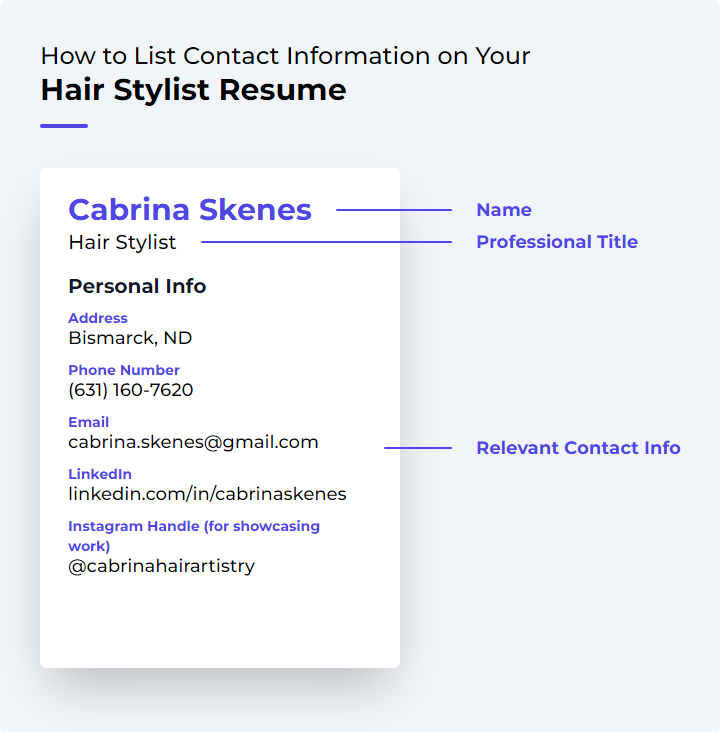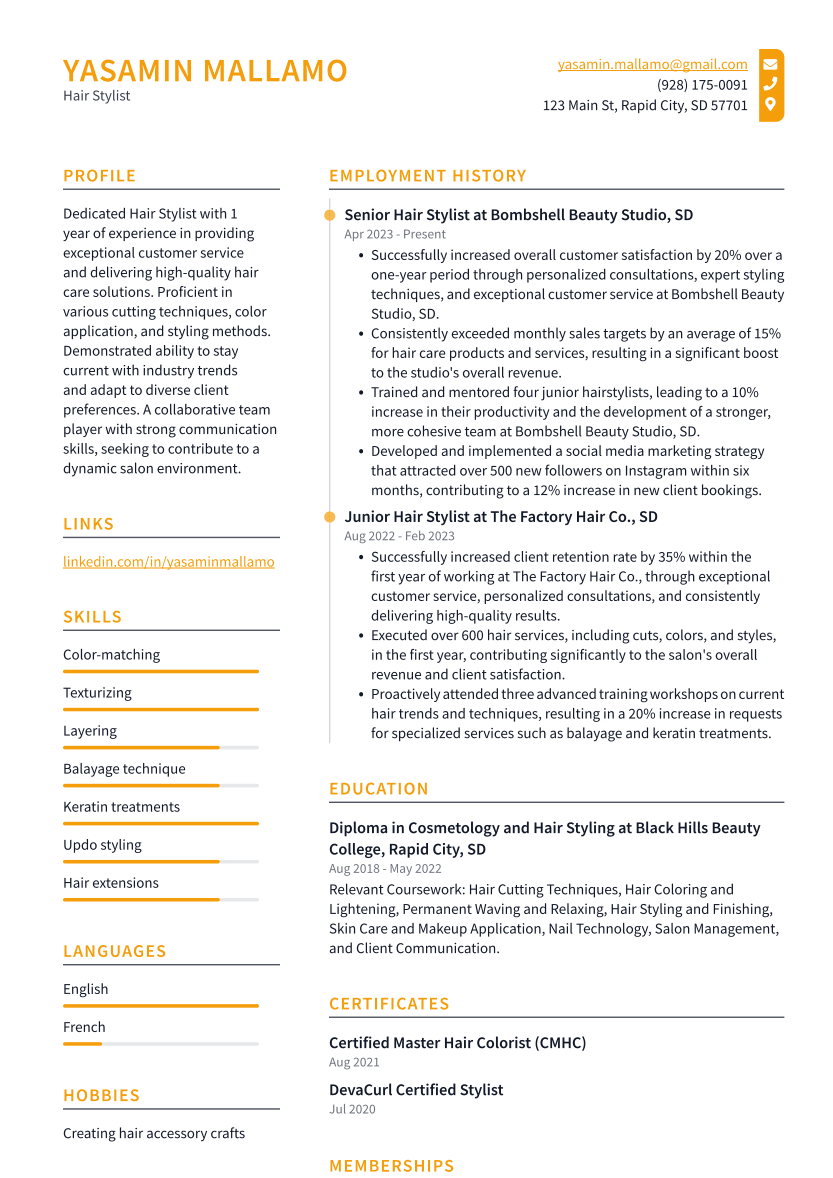Hair Stylist Resume Examples
Writing a great hair stylist resume is important because it is one of the first things a potential employer will see when they are considering you for a position. It is your opportunity to make a good first impression and sell yourself as the best candidate for the job.
Create your resume
Select from 7 professional resume templates
If you're looking for inspiration when it comes to drafting your own hair stylist resume, look no further than the samples below. These resumes will help you highlight your experience and qualifications in the most effective way possible, giving you the best chance of landing the hair stylist job you're after.
Essential Components of a Hair Stylist Resume
A Hair Stylist resume is a professional document that showcases an individual's expertise, work history, and qualifications in the realm of hair styling. It's an essential tool for making a strong first impression on prospective employers and can be instrumental in securing an interview or job offer. An effective resume should highlight key elements such as relevant work experience, specialized skills, certifications, and education. It should also be organized into clear sections that are easy for hiring managers to scan. Below, we'll delve into the details of each section of a Hair Stylist resume, discuss their importance and contents, and provide tips on how to make each section stand out.
1. Contact Information
At the forefront of your resume, your contact information is crucial. It's the first detail employers notice and the means by which they'll contact you for an interview. Ensure it's prominently displayed, accurate, and straightforward.

Lead with your full name in bold or large font. Follow with your professional title - 'Hair Stylist' - to immediately inform hiring managers of your role. Include your current address, and if you're open to relocation or targeting a specific area, mention it here.
Essential contact details like your phone number and email address should be current and professional. Avoid whimsical email handles; opt for one that incorporates your name. If you have a professional website or online portfolio showcasing your work, include the URL. Also, list professional social media accounts, such as LinkedIn or Instagram, where you display your hairstyling prowess, next to the platform's icon for visibility.
Omit personal details like marital status, age, or nationality, as they're irrelevant and could introduce bias.
The contact information section should succinctly include:
- Full Name
- Professional Title (Hair Stylist)
- Current Address
- Phone Number
- Professional Email
- Website/Portfolio (if applicable)
- Professional Social Media Handles (if applicable)
This approach ensures employers can effortlessly reach out to you regarding job opportunities.
2. Objective or Summary Statement
The objective or summary statement is a pivotal element of a hair stylist's resume, positioned just below your contact details. It acts as a brief introduction to your professional persona, setting the stage for a memorable first impression.
In this concise section, highlight your primary skills, experiences, and career goals in hairstyling. Tailor this statement for each job application, aligning your abilities with the job's requirements.
For novices or career changers, an objective statement can outline career objectives and passion for the industry, e.g., "Newly certified hair stylist eager to apply my skills in a dynamic salon environment."
Seasoned hair stylists can use a summary statement to showcase years of experience, areas of expertise, and notable achievements, for instance: "Seasoned hair stylist with over a decade of experience in high-end salons, specializing in modern cutting techniques and color transformations."
This section should not only reflect your career aspirations but also what you can contribute to the employer, marketing yourself as the ideal candidate. Keep it concise yet compelling to encourage further review of your resume.
Related: Top Hair Stylist Resume Objective Examples
3. Skills and Proficiencies
The Skills and Proficiencies section is a showcase of your capabilities in the hair styling domain. Here, employers assess whether you possess the necessary skills to meet their salon's requirements.
- Technical Skills: Proficiency in cutting, coloring, highlighting, perming, and styling for various hair types, as well as knowledge of hair care products.
- Artistic Ability: Creativity in devising and adapting hairstyles to meet client desires.
- Interpersonal Skills: Excellent communication and customer service skills, ensuring client satisfaction.
- Physical Stamina: The ability to stand for extended periods while attending to clients.
- Time Management: Efficient scheduling to accommodate all appointments without delays or rushed services.
- Cleanliness and Organization: Maintaining a tidy work area and orderly arrangement of tools and products.
- Trend Awareness: Staying informed about current fashion trends and innovative styling techniques.
- Salesmanship: The ability to recommend and sell hair care products within the salon.
- Certification/Licensing: Mentioning your cosmetology certification or license adds credibility to your resume, indicating formal training.
Adjust your resume to highlight the skills most valued by the salon to which you're applying.
Related: Hair Stylist Skills: Definition and Examples
4. Work Experience
The Work Experience section is where you demonstrate your practical expertise and accomplishments. It's not just a list of past employment but a narrative of your responsibilities and successes.
List your most recent position first, including the salon or company name, your title, dates of employment, and location. Then, detail your duties and achievements using bullet points for clarity. Emphasize tasks relevant to hair styling, such as cutting, coloring, client relations, and product sales.
- Delivered high-quality haircuts with precision tools.
- Executed expert color treatments, including highlights and full-color applications.
- Cultivated client relationships, resulting in a 30% increase in repeat business.
- Mentored junior stylists in advanced cutting techniques.
Quantify your achievements when possible, as this provides tangible evidence of your impact. If you have extensive experience across various salons or roles, highlight the key responsibilities or skills acquired at each stage.
For those new to hair styling, include relevant internships or apprenticeships. Even unpaid or volunteer work at local salons is valuable if it's pertinent to the role.
Customize this section for each job application, spotlighting experiences that align with the specific position, whether it's bridal hairstyling or men's grooming.
5. Education and Certifications
The Education and Certifications section validates your formal training and qualifications for the hair stylist role.
- Education: While a college degree may not be mandatory, some employers prefer candidates with cosmetology education. List any relevant courses, including the institution and graduation date.
- Cosmetology License: A valid cosmetology license is often a legal requirement and demonstrates your training and proficiency. State your licensure status clearly.
- Additional Certifications: Specialized certifications can set you apart, such as those in specific techniques or customer service.
- Continuing Education: Ongoing learning is crucial in the ever-evolving beauty industry. Include recent courses, workshops, or seminars.
- Apprenticeships/Internships: Completed apprenticeships or internships at reputable salons can count as both education and experience.
This section is scrutinized by hiring managers to ensure you meet the job's basic requirements, so include all pertinent details accurately.
Related: Hair Stylist Certifications
6. Portfolio of Work
A comprehensive work portfolio can significantly enhance a hair stylist's resume. It provides concrete proof of your skill, creativity, and expertise, showcasing the breadth and quality of your work.
Select a variety of high-quality images that represent different hairstyles you've created, such as cuts, colors, updos, and more. Before-and-after shots can highlight your transformative skills, and showcasing a range of hair types and lengths demonstrates versatility. Keep your portfolio current with your latest work.
In today's digital age, an online portfolio is also beneficial. Consider creating a professional website or utilizing platforms like Instagram to effectively display your work. A digital portfolio allows for easy access by potential employers worldwide.
- Include customer testimonials in your portfolio when available, as they can attest to the quality of your service and enhance your credibility.
Every piece in your portfolio should represent your best work, as it plays a critical role in impressing potential employers or clients. Investing time and effort into a stellar portfolio is essential for any hair stylist's career advancement.
7. References
References are an important aspect of any resume, including for hair stylists. They provide potential employers with the opportunity to verify your skills and work ethic from reliable sources who have witnessed your professional performance.
Choose references from various professional relationships, such as former employers, colleagues, or clients, who can speak to your qualifications and character.
When listing references, include their full names, their relationship to you (e.g., former manager at XYZ Salon), their current position and company, and contact information. Always obtain consent from your references before including them on your resume.
Typically, it's best to note "References available upon request" at the end of your resume, providing them only when asked by the employer. This allows you to prepare your references for potential contact.
While references may seem less significant than the experience or skills sections, they are vital in reinforcing your credibility and suitability for the role. Therefore, it's important to choose appropriate references and manage this section with professionalism.
